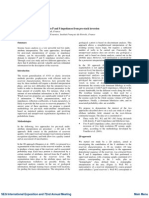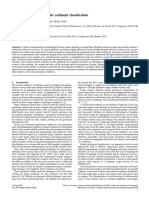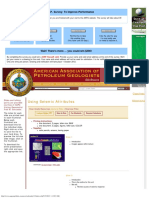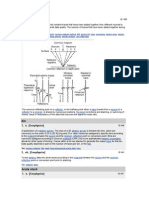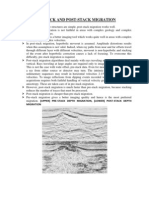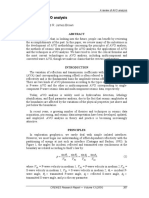Why Spectral Decomposition
Uploaded by
anima1982Why Spectral Decomposition
Uploaded by
anima1982Why Spectral Decomposition Since the development of the coherence cube (Bahorich and Farmer, 1995), seismic attributes
have played an important role in detecting faults and fractures in the earths crust. Other coherence algorithms (e.g. Marfurt et al., 1998; Gersztenkorn and Marfurt, 1999) have been applied to improve the quality of images of faults and fractures. Curvature attributes (Roberts, 2001) are widely now used to enhance the resolution of faults and fractures. However, all these investigations are based on full or dominant-spectrum seismic data. Spectral decomposition (Partyka et al., 1999) provides a novel means of utilizing seismic data, and a method called time-frequency 4-D cube was developed to extract seismic information from seismic data based on the different geologic scales in different frequency bands. Using these methods, discrete frequency coherence cubes (Sun et al., 2010) can be applied to detect faults and fracture zones that cannot be easily detected using the full spectrum coherence data. Application of Spectral Decomposition and Curvature Faults and fractures occur on many scales in the Earth. Therefore, we can detect faults and fractures found at different scales using different frequency bands. Spectral analysis shows that the bandwidth of seismic data of the study area is about 10-55 Hz. Therefore, 10 discrete frequency bands are calculated by increasing frequency sampling by 5 Hz.
Spectral decomposition is a methodology to reveal incised channels on large fans that may incise slope and basin toe in deepwater. This may compare favorably against the standard methods of amplitude, phase and frequency extraction and coherency attributes as it displays the channel image changes over desired windows of the frequency spectrum. Spectral Decomposition may also reveal valuable insight into the depositional history of a region. The spectral decomposition attribute transforms data recorded in space-time to spectral domains, for example using discrete Fourier transformation, and is useful in quantifying seismic waveform variations and thickness within reservoir zones of interests (Partyka and Gridley, 1997). It may often be the case that standard windowed attributes extracted are tuned to the response frequency of the dominant wavelet, which may result in subtle features being masked by this response. Once the spectral decomposition is performed, unsuspected features are revealed that may contribute further insight and understanding with regards to reservoir mapping,delineation of stratigraphic and structural features such as channel sands and complex fault systems.
Sweetness attribute is obtained from reflection intensity and instantaneous frequency attributes, and is helpful in delineating subtle discontinuities such as pinch-outs and channels in stratigraphic traps. It can also be useful for distinguishing shales from sands and will be used in conjunction with spectral decomposition. It attempts to capture the ratio between amplitude and the square root of frequency. Sands tend to be associated with high amplitude and lower frequencies, hence co-blending Sweetness with Variance could give a good control of the extension of stratigraphic features, such as channels and pinchouts.
Spectral decomposition
The Spectral Decomposition method replaces the single input trace with a gather of traces corresponding to the spectral decomposition of the input attribute. The input to spectral decomposition is a seismic volume. The output is several volumes, each one representing a different frequency band. Creating spectral decomposition attributes enables you to illuminate the structures with different frequency bands to see if any of them gives you better resolution.
When doing interpretation it is a common practice to look at instantaneous attributes such as envelope or phase volumes. Spectral decomposition gives you several such volumes. At a specific frequency band certain size structures are more visible due to tuning effects, etc. This means that for example instead of looking at one phase volume for a cube of stacked data, you are able to view several of them and see if any single one shows a structure better.
Spectral decomposition is a form of wavelet transform. The wavelets are short temporal band limited sine and cosine wavelets. In the Frequency Increment mode Gabor wavelets with equally spaced central frequencies are designed and applied to the data, whereas in the octave increment mode, Gabor- Morlet filters are designed with equally spaced central frequencies in octave-frequency domain, hence their representation in thefrequency axis will be unequally spaced.
In spectral decomposition you use complex traces.Basically a single trace is convolved with the first real wavelet to get the real trace for the first frequency, and the input trace is convolved with the first wavelet of the imaginary part to get the imaginary trace. Then a complex trace attribute is constructed, such as envelope, phase, etc. This step is repeated for each filtered wavelet operating on the same trace and obtain band limited traces. (This is very similar to filtering the input trace with several band limited filters and creating a new trace from each filter.) In spectral decomposition the input is a single trace and the output is a series of traces each with a different frequency band. The differences between the FFT type of attributes and these is that FFT attributes give a representation of the wavelet, meaning that when you do FFT of an input trace, you get the spectrum of the source wavelet (assumption is that the reflection coefficients have white spectrum). When you take the FFT of a time limited area, because you did not include enough reflections (short in time) to make the white spectrum assumption, you have the spectrum that is a representation of the reflections coefficients. Also, because you have a limited time window, your resolution in the frequency domain is limited (the shorter the window in time, the wider the frequency band). That is why we refer to frequency bands, rather than frequencies
Geometrical Attributes Spatial discontinuities, such as faults and channels systems,may best be highlighted by attributes such as coherence or variance (Bahorich and Farmer, 1995; Marfurt et al., 1998; Pedersen et al., 2002. Methodologies and workflows now exist to enable the extraction of superior and higher fidelity discontinuity information from these attributes, or from the original seismic data.During the exploration phase, the interpretation of the seismic data may focus on regional or major tectonic elements or fault systems, or alternately at appraisal and development stage, may focus on fault systems for understanding reservoir geometry and connectivity, which may ultimately affect hydrocarbon recovery. Ant Tracking is a proprietary tool for extracting fault information at any scale from seismic data, or may be extracted from a spatial discontinuity attribute volume, such as variance. The outputattribute dataset highlights fault surface features with greater clarity than may be directly interpreted from the original seismic data.
You might also like
- Hourglass Workout Program by Luisagiuliet 276% (21)Hourglass Workout Program by Luisagiuliet 251 pages
- The Hold Me Tight Workbook - Dr. Sue Johnson100% (16)The Hold Me Tight Workbook - Dr. Sue Johnson187 pages
- Read People Like A Book by Patrick King-Edited62% (66)Read People Like A Book by Patrick King-Edited12 pages
- Livingood, Blake - Livingood Daily Your 21-Day Guide To Experience Real Health77% (13)Livingood, Blake - Livingood Daily Your 21-Day Guide To Experience Real Health260 pages
- COSMIC CONSCIOUSNESS OF HUMANITY - PROBLEMS OF NEW COSMOGONY (V.P.Kaznacheev,. Л. V. Trofimov.)94% (212)COSMIC CONSCIOUSNESS OF HUMANITY - PROBLEMS OF NEW COSMOGONY (V.P.Kaznacheev,. Л. V. Trofimov.)212 pages
- Donald Trump & Jeffrey Epstein Rape Lawsuit and Affidavits83% (1016)Donald Trump & Jeffrey Epstein Rape Lawsuit and Affidavits13 pages
- The 36 Questions That Lead To Love - The New York Times94% (34)The 36 Questions That Lead To Love - The New York Times3 pages
- The 36 Questions That Lead To Love - The New York Times95% (21)The 36 Questions That Lead To Love - The New York Times3 pages
- Jeffrey Epstein39s Little Black Book Unredacted PDF75% (12)Jeffrey Epstein39s Little Black Book Unredacted PDF95 pages
- The 4 Hour Workweek, Expanded and Updated by Timothy Ferriss - Excerpt23% (954)The 4 Hour Workweek, Expanded and Updated by Timothy Ferriss - Excerpt38 pages
- AAPG Slide - Lecture-8 - Seismic Resolution - by Fred Schroeder.No ratings yetAAPG Slide - Lecture-8 - Seismic Resolution - by Fred Schroeder.7 pages
- What Is Seismic Interpretation? Alistair BrownNo ratings yetWhat Is Seismic Interpretation? Alistair Brown4 pages
- Pe20m017 Vikrantyadav Modelling and InversionNo ratings yetPe20m017 Vikrantyadav Modelling and Inversion18 pages
- Seismic Facies Analysis Applied To P and S Impedances From Pre-Stack InversionNo ratings yetSeismic Facies Analysis Applied To P and S Impedances From Pre-Stack Inversion4 pages
- Residual Oil Saturation: The Information You Should Know About SeismicNo ratings yetResidual Oil Saturation: The Information You Should Know About Seismic9 pages
- Qualitative-Quantitative Seis Interp-TionNo ratings yetQualitative-Quantitative Seis Interp-Tion21 pages
- Depth Conversion of Time Interpretations Volume ModelsNo ratings yetDepth Conversion of Time Interpretations Volume Models53 pages
- Galloway 1989 Genetic Stratigraphic Sequence Basin Analysis INo ratings yetGalloway 1989 Genetic Stratigraphic Sequence Basin Analysis I18 pages
- 3-D Seismic and Horizontal Wells - SEISMIC INTERPRETATION 31No ratings yet3-D Seismic and Horizontal Wells - SEISMIC INTERPRETATION 315 pages
- Crooked-Line 2D Seismic Reflection Imaging in Crystalline Terrains: Part 2, MigrationNo ratings yetCrooked-Line 2D Seismic Reflection Imaging in Crystalline Terrains: Part 2, Migration11 pages
- Amplitude Variation With Frequency As Direct Hydrocarbon Indicator For Quick Look and Different Insight of Hydrocarbon DelineationNo ratings yetAmplitude Variation With Frequency As Direct Hydrocarbon Indicator For Quick Look and Different Insight of Hydrocarbon Delineation7 pages
- New Methods IN Shallow Seismic Reflection: Zuhar Zahir Tuan HarithNo ratings yetNew Methods IN Shallow Seismic Reflection: Zuhar Zahir Tuan Harith336 pages
- Use of Seismic Attributes For Sediment Classificat PDFNo ratings yetUse of Seismic Attributes For Sediment Classificat PDF15 pages
- 2d 3d 4d Exploracion Sismica para Geologos CH Liner Conex - Mayo 1999No ratings yet2d 3d 4d Exploracion Sismica para Geologos CH Liner Conex - Mayo 1999388 pages
- Depth Conversion of Post Stack Seismic Migrated Horizon Map MigrationNo ratings yetDepth Conversion of Post Stack Seismic Migrated Horizon Map Migration11 pages
- What Kind of Vibroseis Deconvolution Is Used - Larry MewhortNo ratings yetWhat Kind of Vibroseis Deconvolution Is Used - Larry Mewhort4 pages
- AAPG Slides - Lecture-11 - Stratigraphic Analysis - Interpretation - by Fred Schroeder.No ratings yetAAPG Slides - Lecture-11 - Stratigraphic Analysis - Interpretation - by Fred Schroeder.6 pages
- AAPG Slides - Lecture-13 - Using Seismic Attributes - by Fred SchroederNo ratings yetAAPG Slides - Lecture-13 - Using Seismic Attributes - by Fred Schroeder11 pages
- M49 Unit4 3D Seismic Attributes1 Fall2009No ratings yetM49 Unit4 3D Seismic Attributes1 Fall200980 pages
- N. (Geophysics) : Seismic Record Noise FoldNo ratings yetN. (Geophysics) : Seismic Record Noise Fold84 pages
- The Integrated Approach To Seismic Attributes of Lithological Characterization of Reservoirs: Case of The F3 Block, North Sea-Dutch SectorNo ratings yetThe Integrated Approach To Seismic Attributes of Lithological Characterization of Reservoirs: Case of The F3 Block, North Sea-Dutch Sector20 pages
- Seismic Wavelet Estimation - A Frequency Domain Solution To A Geophysical Noisy Input-Output Problem100% (2)Seismic Wavelet Estimation - A Frequency Domain Solution To A Geophysical Noisy Input-Output Problem11 pages
- TG Structural Interpretation Ganjil 20-21No ratings yetTG Structural Interpretation Ganjil 20-2179 pages
- Polarity: American Polarity Standard European (Or Australian) Polarity StandardNo ratings yetPolarity: American Polarity Standard European (Or Australian) Polarity Standard55 pages
- Crooked-Line 2D Seismic Reflection Imaging in Crystalline Terrains: Part 1, Data ProcessingNo ratings yetCrooked-Line 2D Seismic Reflection Imaging in Crystalline Terrains: Part 1, Data Processing12 pages
- GEO ExPro - Geophysics - A Simple Guide To Seismic Amplitudes and DetuningNo ratings yetGEO ExPro - Geophysics - A Simple Guide To Seismic Amplitudes and Detuning11 pages
- 4D Seismic Analysis: Robertson Research International LTDNo ratings yet4D Seismic Analysis: Robertson Research International LTD35 pages
- (AAPG Studies in Geology 53) John H. Shaw - Seismic Interpretation of Contractional Fault-Related Folds - An AAPG Seismic Atlas-American Association of Petroleum Geologists (2005)100% (1)(AAPG Studies in Geology 53) John H. Shaw - Seismic Interpretation of Contractional Fault-Related Folds - An AAPG Seismic Atlas-American Association of Petroleum Geologists (2005)170 pages
- 2010 04 RECORDER Model Based Seismic Inversion0% (1)2010 04 RECORDER Model Based Seismic Inversion12 pages
- RMS Seismic Attributes With RGB Color Blending Technique For Fault InterpretationNo ratings yetRMS Seismic Attributes With RGB Color Blending Technique For Fault Interpretation7 pages
- Rivers and Floodplains: Forms, Processes, and Sedimentary RecordFrom EverandRivers and Floodplains: Forms, Processes, and Sedimentary RecordNo ratings yet
- Keyboard Question and Answer Pre-PrimaryNo ratings yetKeyboard Question and Answer Pre-Primary1 page
- VSP Data Interpretation and Processing PDFNo ratings yetVSP Data Interpretation and Processing PDF214 pages
- Insight Method of 4d Reservoir Monitoring PDF100% (1)Insight Method of 4d Reservoir Monitoring PDF234 pages
- Bhavan, Sector 11, Gandhinagar-382010, GujaratNo ratings yetBhavan, Sector 11, Gandhinagar-382010, Gujarat2 pages
- Bhavan, Sector 11, Gandhinagar-382010, GujaratNo ratings yetBhavan, Sector 11, Gandhinagar-382010, Gujarat2 pages
- ABR Architects: Architect & Interior DesignerNo ratings yetABR Architects: Architect & Interior Designer1 page
- Ch1 - Depositional Facies and Environments Significance in Petroleum ExplorationNo ratings yetCh1 - Depositional Facies and Environments Significance in Petroleum Exploration43 pages
- Qualifying Interpretation Assets: 17 June 2010 - Eage Daily NewsNo ratings yetQualifying Interpretation Assets: 17 June 2010 - Eage Daily News1 page
- Ch2 - Basic Principles of Facies AnalysisNo ratings yetCh2 - Basic Principles of Facies Analysis6 pages
- Anima Rani Das: Architect & Interior DesignerNo ratings yetAnima Rani Das: Architect & Interior Designer1 page
- Improving Resolution With Spectral Balancing-A Case Study: M Fatima, Lavendra Kumar, RK Bhattacharjee, PH Rao, DP SinhaNo ratings yetImproving Resolution With Spectral Balancing-A Case Study: M Fatima, Lavendra Kumar, RK Bhattacharjee, PH Rao, DP Sinha8 pages
- Scaling Mode Shapes Obtained From Operating Data: Brian Schwarz & Mark RichardsonNo ratings yetScaling Mode Shapes Obtained From Operating Data: Brian Schwarz & Mark Richardson8 pages
- UVM-based Solution For Mixed Signal VerificationNo ratings yetUVM-based Solution For Mixed Signal Verification9 pages
- Perfect Pulses For Ambient Backscatter Communication: Erfect UlsesNo ratings yetPerfect Pulses For Ambient Backscatter Communication: Erfect Ulses7 pages
- An Ensemble 1D-CNN-LSTM-GRU Model With Data Augmentation For Speech Emotion RecognitionNo ratings yetAn Ensemble 1D-CNN-LSTM-GRU Model With Data Augmentation For Speech Emotion Recognition19 pages
- Non-Mandatory Appendix: QR-A6000 Seismic Qualification RequirementsNo ratings yetNon-Mandatory Appendix: QR-A6000 Seismic Qualification Requirements5 pages
- 2 Determination of Dynamic Modulus of Elasticity of Concrete by Impact Hammer PDFNo ratings yet2 Determination of Dynamic Modulus of Elasticity of Concrete by Impact Hammer PDF4 pages
- Complete Download A Student s Guide to Laplace Transforms Student s Guides Daniel Fleisch PDF All Chapters100% (1)Complete Download A Student s Guide to Laplace Transforms Student s Guides Daniel Fleisch PDF All Chapters65 pages
- 6 Pitch Perception Models: Alain de CheveignéNo ratings yet6 Pitch Perception Models: Alain de Cheveigné69 pages





































